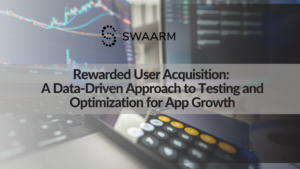As of 2022, there are approximately 2.3 million apps in the Apple App Store and 3.5 million in the Google Play Store, indicating the intense competition among app creators for our attention. And with a staggering 255 billion mobile app downloads worldwide in 2022, it’s therefore become imperative for app developers to efficiently and cost-effectively attract new users, ensuring that their customer acquisition cost (CAC) remains low.
Needless to say, with millions of apps available in app stores, user acquisition has become indispensable for any mobile developer hoping to flourish. In this article, we will provide an overview of the topic and its significance, examining the importance of user acquisition when building a successful app.
I. Understanding your target audience
1. Defining your target audience
Developing a well-defined user acquisition plan that outlines specific strategies and tactics is necessary to attract and retain your target audience. One of the first steps you should therefore take is to define your potential customers’ demographics, interests, and behaviors.
By conducting market research and competitor analysis, app developers can gain insights into their target audience’s preferences, interests, and behaviors, allowing app creators and marketers to tailor their user acquisition efforts and marketing messaging more effectively.
Photo by Microsoft 365 on Unsplash
2. Create user personas
User personas are fictional representations of your target audience segments. By creating user personas, you can visualize your ideal users and get an idea of their needs, motivations, and pain points. This information will enable you to create personalized marketing campaigns and improve user acquisition efforts.
However, more than simply acquiring users, it is equally important to measure and evaluate the effectiveness of these acquisition techniques. This is where calculating the customer acquisition cost (CAC) and other metrics come into play, enabling app developers to assess their user acquisition strategies’ efficiency and return on investment.
II. Setting goals and key performance indicators (KPIs)
Setting clear and specific goals is essential for measuring the success of your user acquisition strategies. To do so, determine what you want to achieve through user acquisition. Are you looking to increase app downloads, boost user engagement, or drive conversions? Whatever your desired outcome, setting goals will serve as a roadmap for your acquisition plan.
For example, by monitoring and optimizing the customer acquisition cost, app developers can identify which acquisition channels and tactics yield the best results, enabling them to make informed decisions when allocating resources.
Moreover, with a well-defined user acquisition plan and a thorough understanding of the CAC, app developers can navigate the competitive app market and maximize their chances of success.
Part of this process involves key performance indicators (KPIs), metrics used to measure the effectiveness of attempts at user acquisition. To succeed, pick KPIs that align with your goals, such as the number of app downloads, user retention rates, cost per acquisition (CPA), and
return on ad spend (ROAS).
To gauge the performance of your acquisition campaigns, make sure to regularly track and analyze these KPIs. And remember, you can change the campaigns to optimize them and get the best results possible.
1. Setting realistic and measurable targets
To ensure the effectiveness of your user acquisition plan’s effectiveness, setting realistic and measurable targets is paramount. To achieve this, you should define specific targets for each KPI, considering factors such as your app’s niche, competition, and available resources. Setting achievable targets will also help you stay focused and motivated throughout the acquisition process.
III. Picking user acquisition channels
1. Evaluating different user acquisition channels
Unsurprisingly, today there are various user acquisition channels you can use. These include:
- Organic
- Paid advertising
- Social media
- App Store Optimization (ASO)
- Content marketing
- Influencer marketing
Based on your target audience, budget, and goals, you should evaluate which channels suit your needs before using any of them. Most importantly, use a multi-channel approach to get optimal results.
Photo by Microsoft 365 on Unsplash
2. Testing and optimizing user acquisition channels
Before finalizing a user acquisition channel, test and optimize your strategies. Conduct A/B tests and analyze performance metrics so that you can make data-driven decisions to refine your campaigns. To get the best results, it is vital to continuously monitor and adjust your user acquisition strategies.
IV. Implement user retention strategies
1. Focusing on user experience and engagement
Acquiring new customers is, of course, essential to any thriving business, but retaining existing customers is equally important too. To do so, focus on enhancing your user experience by implementing some of the following techniques:
- Seamless and intuitive interface
- Sending personalized recommendations
- Providing timely customer support
- Encouraging user engagement through in-app notifications
- Incorporating gamification features
- Implementing loyalty programs
2. Analyzing user behavior and feedback
Understanding your users’ needs and preferences will create a more compelling user experience, thereby increasing your user retention rates too. To reach this goal, regularly analyze user behavior within your app to identify patterns and areas for improvement. You should also leverage user feedback and reviews to address pain points and enhance the app’s features and functionalities.
Photo by Campaign Creators on Unsplash
V. Developing a content marketing strategy
1. Creating valuable and relevant content for your target audience
To reach the right target audience, companies need to create interesting, valuable, relevant, and engaging content. Doing this isn’t simple, but there are some shortcuts. First, it’s important to understand your potential customers’ needs, interests, and pain points. To achieve this, the answer is simple: marketing research. Once you have enough information, you need to tailor your content to provide solutions, entertainment, and insights that resonate with your prospects. From here, the content you subsequently create should be available either as blog posts, videos, infographics, and/or engaging visuals.
For maximum results, produce some interactive content showcasing your app’s benefits and unique features.
2. Utilizing blogging, guest posting, and social media to promote your app
Once you’ve created some compelling content, your next task is to promote it. One effective method is blogging, where you can publish articles on your own website or contribute guest posts to relevant industry publications. Blogging can help establish your app as a thought leader, driving traffic to your app’s website or landing page.
Additionally, leveraging social media platforms such as Facebook, Instagram, and Twitter can expand your reach, assisting you in directly engaging with your target audience. By sharing valuable content, running contests or giveaways, and interacting with users, you can build a community around your app, generating interest and awareness.
3. Leveraging content marketing to drive app downloads and user engagement
While content marketing helps build awareness and engagement, it should also be geared toward driving app downloads and user acquisition. One way of achieving this is by encouraging users to undertake a certain action through subtle yet compelling call-to-actions (CTAs) within your content. For instance, a CTAs could be something directing users to download your app or sign up for a trial.
Furthermore, you can optimize your content for search engines by using relevant keywords and meta tags, as well as by optimizing your website for mobile devices. Doing so will ensure that your content is easily discoverable by users searching for solutions or information related to your app, increasing the chances of driving app downloads and user engagement.
VI Implementing paid advertising campaigns
1. Selecting the right ad platforms (e.g., Google Ads, Facebook Ads)
Since paid advertising campaigns can significantly boost user acquisition, selecting ad platforms that align with your target audience and app niche is, therefore, essential. Platforms such as Facebook and Google Ads offer powerful and the best targeting options that enable you to connect with users based on demographics, interests, and behaviors. By carefully researching and analyzing your target audience, you can also determine which platforms will most likely yield the highest return on investment for your app.
2. Setting up and optimizing ad campaigns
Once you have chosen some ad platforms, the next step is setting up and optimizing your ad campaigns. This process involves crafting compelling ad copy, designing eye-catching visuals and videos, and selecting ad formats that will capture the target audience’s attention.
Additionally, you should also continuously monitor and optimize your campaigns by analyzing key metrics such as click-through rates (CTRs), conversion rates, and cost per acquisition (CPA). This will allow you to identify what is working and make data-driven adjustments to maximize the performance of your paid advertising campaigns.
3. Monitoring and measuring ad-campaign performance
Monitoring the performance of your ad campaigns is crucial to understanding their effectiveness as well as comprehending your return on investment. You can measure key metrics such as impressions, clicks, conversions, and cost per install (CPI).
Using tracking tools and analytics platforms, these metrics are easy to assess. This data also provides insight into the performance of your campaigns, making areas for improvement simple to identify.
Indeed, in order to ensure that your paid advertising efforts are driving app downloads and user acquisition, analyzing and optimizing campaigns according to these metrics should be a regular task.
VII. Leveraging influencer marketing
1. Identifying influencers relevant to your app’s niche
Influencer marketing is undoubtedly one of the best and most powerful strategies to promote your app to a wider audience. If you use this strategy, however, one of the first things you need to do is to identify influencers with a strong following and presence in your app’s niche. You must also look for influencers with content and values that align with your company’s.
Today, many different types of influencers are found, such as YouTubers, bloggers, Instagrammers, and/or industry experts, that have credibility and significant influence in any industry.
2. Collaborating with influencers to promote your app
Once you have identified the influencers you want to work with, contact them to discuss potential collaborations.
Offer them incentives such as free access to your app, exclusive discounts, and monetary compensation for promoting your service to their audience.
Collaborating with influencers to create engaging and authentic content is also a good way of showcasing your app’s value and benefits. Such collaborations could include sponsored posts, reviews, tutorials, or giveaways. By leveraging the trust and influence of influencers, you can tap into their audience and drive app downloads and user engagement.
3. Measuring the impact and ROI of influencer marketing efforts
If you want to ensure the success and effectiveness of your influencer marketing campaigns, measuring their impact and return on investment (ROI) is vital. To accomplish this, you should track key metrics such as engagement rates, click–through rates, app downloads, and user acquisition attributed to the influencer campaigns. Utilizing tracking tools, referral codes, and custom landing pages will also accurately measure the performance and effectiveness of each influencer partnership. Analyzing these metrics lets you identify the most effective influencers and optimize your influencer marketing strategy accordingly.
Conclusion
In conclusion, building a successful user acquisition plan for your app requires a multifaceted approach. By developing a content marketing strategy, implementing paid advertising campaigns, and leveraging influencer marketing, you can effectively promote your app, drive app downloads, and engage users.
Moreover, to ensure maximum results—and to bring down customer acquisition costs—it is also important to continuously monitor and optimize your strategies based on data and metrics. With a well-executed user acquisition plan, you can increase your app’s visibility, attract a targeted audience, and ultimately drive your app’s success and growth.






